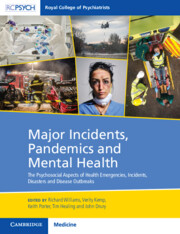 Major Incidents, Pandemics and Mental Health
Major Incidents, Pandemics and Mental Health Book contents
- Major Incidents, Pandemics and Mental Health
- Major Incidents, Pandemics and Mental Health
- Copyright page
- Dedication
- Contents
- Figures
- Tables
- Boxes
- Contributors
- Foreword by Dr Adrian James
- Foreword by Professor David Lockey
- Section 1 The Nature and Impacts of Twenty-First-Century Healthcare Emergencies
- Section 2 Clinical Aspects of Traumatic Injuries, Epidemics, and Pandemics
- Section 3 The Role of the Public in Emergencies: Survivors, Bystanders, and Volunteers
- Chapter 19 The Role of the Public: Understanding Group Processes in Emergencies, Incidents, Disasters, and Disease Outbreaks
- Chapter 20 Social Identity and Traumatic Stress in the Context of an Earthquake and a Pandemic
- Chapter 21 Mobilisation and Deterioration of Social Support Following Disasters Resulting from Natural and Human-Induced Hazards
- Chapter 22 Collective Responses to Terrorist Attacks
- Chapter 23 Collective Psychosocial Resilience as a Group Process Following Flooding
- Chapter 24 Facilitating the Public Response to COVID-19
- Chapter 25 The Social Psychology of Mass Casualty Decontamination in Chemical, Biological, Radiological, or Nuclear (CBRN) Incidents
- Chapter 26 Factors That Determine Wider Solidarity Responses After a Major Incident or Disaster
- Section 4 Responses to Meet the Mental Health Needs of People Affected by Emergencies, Major Incidents, and Pandemics
- Section 5 Sustaining and Caring for Staff During Emergencies
- Section 6 Designing, Leading, and Managing Responses to Emergencies and Pandemics
- Section 7 Key Lessons for the Way Forward
- A Glossary of Selected Key Terms Used in This Book
- Index
- References
Chapter 23 - Collective Psychosocial Resilience as a Group Process Following Flooding
How It Arises and How Groups Can Sustain It
from Section 3 - The Role of the Public in Emergencies: Survivors, Bystanders, and Volunteers
Published online by Cambridge University Press: 11 January 2024
- Major Incidents, Pandemics and Mental Health
- Major Incidents, Pandemics and Mental Health
- Copyright page
- Dedication
- Contents
- Figures
- Tables
- Boxes
- Contributors
- Foreword by Dr Adrian James
- Foreword by Professor David Lockey
- Section 1 The Nature and Impacts of Twenty-First-Century Healthcare Emergencies
- Section 2 Clinical Aspects of Traumatic Injuries, Epidemics, and Pandemics
- Section 3 The Role of the Public in Emergencies: Survivors, Bystanders, and Volunteers
- Chapter 19 The Role of the Public: Understanding Group Processes in Emergencies, Incidents, Disasters, and Disease Outbreaks
- Chapter 20 Social Identity and Traumatic Stress in the Context of an Earthquake and a Pandemic
- Chapter 21 Mobilisation and Deterioration of Social Support Following Disasters Resulting from Natural and Human-Induced Hazards
- Chapter 22 Collective Responses to Terrorist Attacks
- Chapter 23 Collective Psychosocial Resilience as a Group Process Following Flooding
- Chapter 24 Facilitating the Public Response to COVID-19
- Chapter 25 The Social Psychology of Mass Casualty Decontamination in Chemical, Biological, Radiological, or Nuclear (CBRN) Incidents
- Chapter 26 Factors That Determine Wider Solidarity Responses After a Major Incident or Disaster
- Section 4 Responses to Meet the Mental Health Needs of People Affected by Emergencies, Major Incidents, and Pandemics
- Section 5 Sustaining and Caring for Staff During Emergencies
- Section 6 Designing, Leading, and Managing Responses to Emergencies and Pandemics
- Section 7 Key Lessons for the Way Forward
- A Glossary of Selected Key Terms Used in This Book
- Index
- References
Summary
Flooding can severely affect wellbeing through both primary stressors and secondary stressors. The impacts may be mitigated by community resilience; this may be used deliberately or unwittingly by people affected and the responsible authorities. Using data from England and Ireland, we address collective psychosocial resilience – that is, the way in which shared social identification allows groups to spontaneously emerge and mobilise solidarity and social support. First, we show that shared social identity can emerge during floods due to experiencing a common fate, and this leads to communities mobilising social support. Second, we show that emergent shared social identity can decline due to a lack of perceived common fate, the disappearance of collective identity, or inequalities experienced after the disaster. However, social identity can be sustained by communities providing social support, by persisting secondary stressors, or intentionally by holding commemorations. Additionally, shared social identity is associated with observed unity.
Keywords
- Type
- Chapter
- Information
- Major Incidents, Pandemics and Mental HealthThe Psychosocial Aspects of Health Emergencies, Incidents, Disasters and Disease Outbreaks, pp. 160 - 165Publisher: Cambridge University PressPrint publication year: 2024
